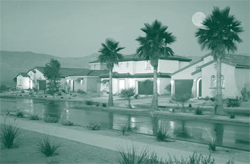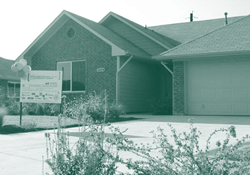May 2008
In this Issue
Housing: Critical for Working Families and Communities
Rewarding Design and Innovation
Affordable and Green?
Assessing GSE Performance
In the next issue of ResearchWorks
Rewarding Design and Innovation
The winners of the 2007 HUD Secretary's Best in American Living Award (BALA), sponsored by Professional Builder magazine and the National Association of Home Builders, were announced in February 2008. Three developments were honored for design excellence and innovation in affordable housing: Falcon Crest in California, the Roanoke and Lee Street Housing Project in Virginia, and Nevada Court in Texas.
The winning projects all:
-
Have ENERGY STAR® appliances and home ratings;
-
Target first-time homebuyers with low or moderate incomes;
-
Offer assistance with financing; and
-
Have homes that sell for less than the median home price in their respective metropolitan statistical areas.
Falcon Crest

Falcon Crest in Palm Desert, California has 93 affordable and sustainable single-family homes, each with 3 or 4 bedrooms. By incorporating green technologies, these homes exceed California's energy-efficiency standards by nearly 20 percent. Sustainable features include photovoltaic panels that cannot be viewed from the street, xeriscaping, panelized framing, and low-impact development site drainage.
The Spanish Revival-style homes in Falcon Crest feature recessed windows, brick and tile entry surrounds, decorative awnings, and wood-grained garage doors. The homes also incorporate universal design features to accommodate elderly or disabled family members, allowing residents to age in place.
To make the homes more affordable, up to $50,000 in deferred payments from the local government, $30,000 in grants for downpayment assistance from California’s Department of Housing and Community Development, and below-market interest rates from the California Housing Finance Agency are available to qualified homebuyers. Resale restrictions ensure that these homes will remain affordable for 45 years.
The Roanoke and Lee Street Housing Project
The Roanoke and Lee Street Housing Project in Blacksburg, Virginia — described in the July/August 2007 issue of ResearchWorks — is an infill project of 14 duplexes within walking distance of downtown civic and retail amenities. The development incorporates green, sustainable materials and systems, such as cellulose insulation made from recycled paper (which reduces air infiltration, heat transfer, and sound transmission), double-paned vinyl windows with low-E glass, high-efficiency heat pumps, and HVAC systems that are up to 30 percent more efficient than those in the average new home. To blend in with the neighborhood, the homes feature front porches with metal roofs.
To make the Roanoke and Lee Street Housing Project affordable, a small cities community development block grant (CDBG) from Virginia's Department of Housing and Community Development, as well as HUD CDBG funds resulting from the town’s designation as an entitlement community, subsidized construction costs. These resources, along with sweat equity and below-market permanent mortgages, help keep the homes within reach for low- to moderate-income homebuyers.
Nevada Court

Energy-efficient technologies and durable materials were also part of the plan to build affordable green homes in Nevada Court in Denton, Texas. Features incorporated in this project's 14 homes include water-conserving faucets, showerheads, and dual-flush toilets. Installing ductwork in air-conditioned spaces and meticulously sealing the building envelope enabled the developer to guarantee low utility costs, anticipated to be no more than $50 per month. The homes have no products containing formaldehyde or other off-gassing chemicals, resulting in improved indoor air quality. Outside, each home is xeriscaped with drought-resistant native plants and is equipped with rainwater harvesting technologies.
Funding from the Federal Home Loan Bank of Dallas and HOME funds from the city of Denton provided low- to moderate-income homebuyers with assistance for downpayments and closing costs. Several building material and systems manufacturers provided reduced-cost supplies in exchange for public relations exposure, which helped offset development costs and made the homes more affordable.
The 2007 BALA award recipients all feature affordable homes that are innovatively designed and energy efficient. Details on the BALA award, as well as other HUD Secretary Award programs, are available at www.huduser.gov/research/secaward.html.
The July/August 2007 issue of ResearchWorks (volume 4, number 7) is available from HUD USER free of charge by calling 800.245.2691, option 1, or by visiting www.huduser.gov/periodicals/ResearchWorks/ResearchWorks.html.

